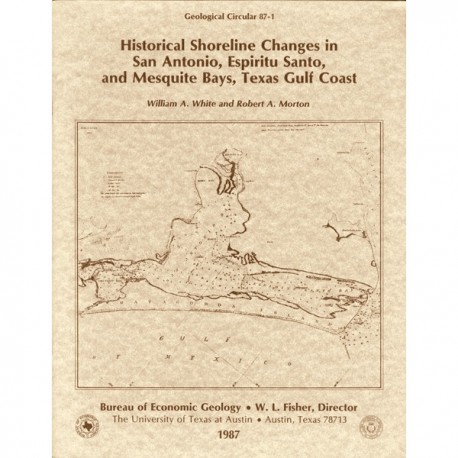Geological Circulars
-
Books & Reports
- Reports of Investigations
- Guidebooks
- Udden Series
- Geological Circulars
- Down To Earth
- Atlases of Major Oil and Gas Reservoirs
- Texas Memorial Museum Publications
- Environmental Geologic Atlas of the Texas Coastal Zone
- Mineral Resource Circulars
- Other Reports
- Seminars and Workshops
- Handbooks
- Submerged Lands of Texas
- Symposia
- Annual Reports
- Open File Reports
-
Maps & Cross Sections
- Thematic Maps
- Miscellaneous Maps, Charts & Sections
- Geologic Atlas of Texas
- STATEMAP Project Maps
- Geologic Quadrangle Maps
- Cross Sections
- Highway Geology Map
- Energy and Mineral Resource Maps
- Shoreline Change and Other Posters
- Wilcox Group, East Texas, Geological / Hydrological Folios
- Bouguer Gravity Atlas of Texas
- River Basin Regional Studies
- Featured Maps
- Posters
- Teachers & the Public
-
Geological Society Publications
- Gulf Coast Association of Geological Societies
- Alabama Geological Society
- Austin Geological Society
- Corpus Christi Geological Society
- Houston Geological Society
- Lafayette Geological Society
- Mississippi Geological Society
- New Orleans Geological Society
- South Texas Geological Society
- GCS SEPM Publications
- Historic BEG & UT Series
Historical Shoreline Changes in San Antonio, Espiritu Santo, and Mesquite Bays, Texas Gulf Coast
GC8701
For a downloadable, digital version: GC8701D.
GC8701. Historical Shoreline Changes in San Antonio, Espiritu Santo, and Mesquite Bays, Texas Gulf Coast, by W. A. White and R. A. Morton. 41 p., 31 figs., 1 table, 3 appendices, 1987. ISSN: 0082-3309. Print.
To purchase this publication as a downloadable PDF, please order GC8701D.
ABSTRACT
Changes in the position and stability of shorelines in the San Antonio Bay system (San Antonio, Espiritu Santo, and Mesquite Bays), Texas Gulf Coast, were documented using historical monitoring techniques. Documenting long term shoreline movement included comparing shorelines on topographic surveys (dated 1857 to 1860) with aerial photographs (taken between 1929 and 1937 and in 1957, 1974, and 1982), measuring the magnitude (distance) of shoreline movement at specific sites, calculating the rates of change during particular periods (late 1800’s to 1930’s, 1930’s to 1982, and late 1800’s to 1982), and summarizing in tables and on maps the magnitudes and rates of shoreline change. Geological interpretations of the maps and photographs are used in conjunction with meteorological data and historical records to explain important shoreline stability trends.
Unprotected sediments forming the margins of the San Antonio Bay system are modified by natural coastal processes and by human activities, both of which cause shoreline movement. Shorelines not stabilized by man-made structures occur along high, nearly vertical clay bluffs, salt-water marshes, and sand and shell beaches, at the base of moderate and steep slopes composed mainly of sand, and in newly formed areas filled by dredged material. Composition of the shoreline material and orientation of the shoreline with respect to prevailing wind direction and wave fetch largely determine the response and consequent movement of the shoreline. In some areas, property owners have attempted to stabilize the shoreline and prevent further movement by building seawalls and bulkheads and by using riprap to dissipate wave energy.
Historical shoreline changes in the San Antonio Bay system are predominantly erosional; about 70 percent of long-term (a period of about 120 yr) net erosion occurred at rates of between 0.2 and 3 ft/yr. The highest rate of long-term net erosion is 11 ft/yr. Recent short-term rates are locally higher. Contributing to shoreline changes are (1) regional and worldwide climate, (2) local changes in relative sea level, (3) local alterations in sediment supply, (4) frequent and intense storms, and (5) human activities. Historical data indicate that increasing temperatures, rising sea level, decreasing sediment supply, recurring severe storms, and ongoing human activities all promote continued erosion of most unprotected shorelines of San Antonio, Espiritu Santo, and Mesquite Bays.
Keywords: Texas Coastal Zone, shoreline changes, shoreline protection, San Antonio Bay, Espiritu Santo Bay, Matagorda Island, coastal processes, geologic hazards, Texas
Citation
White, W. A., and Morton, R. A., 1987, Historical Shoreline Changes in San Antonio, Espiritu Santo, and Mesquite Bays, Texas Gulf Coast: The University of Texas at Austin, Bureau of Economic Geology, Geological Circular 87-1, 41 p.


